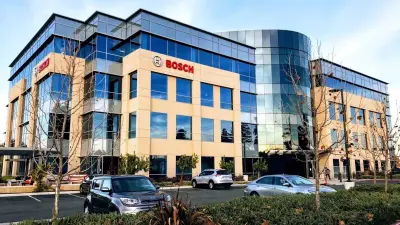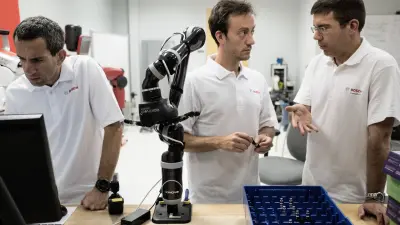Research and Technology Center North America
Part of a strong international team
Founded in 1999, the North American division of Corporate Research at Bosch has been shaping the technology of Bosch’s future for nearly 20 years. The team has worked in close collaboration with its colleagues and counterparts in Germany and around the world.

At Bosch, some 59,000 researchers and developers work at 120 locations worldwide, making our company one of the world’s leading international providers of technology and services. Over the past six years, Bosch has invested more than 27 billion euros ($33 billion) in research and development.

Our objective is to develop innovative, useful and exciting products and solutions to enhance our quality of living. At Bosch, we create technology that is “Invented for life.” We are committed to providing technologies and systems for the four business sectors of Bosch -- Mobility Solutions, Energy and Building Technology, Industrial Technology and Consumer Goods -- by scouting and collaborating with top universities and industry partners in North America.
What drives us?
Our Locations in North America
The Research and Technology Center North America was established at three locations in close proximity to world-class universities and entrepreneurial ecosystems. We are headquartered in Sunnyvale, CA -- right in the heart of Silicon Valley -- and have additional offices in Pittsburgh, Pennsylvania, and Cambridge, Massachusetts.
At these locations, Bosch hosts over 100 researchers and various technical labs that employ state-of-the-art equipment, such as the Robotics Lab, Battery Research Lab, Human Machine Interaction Research Lab, Biosensors lab, Microsensor Systems Lab and Integrated Circuits Lab.
-

Sunnyvale, CA -

Pittsburgh, PA -

Cambridge, MA
Our Impact
Part of our mission is to leverage our locations in North America to collaborate with universities and companies. These partnerships help incubate early-stage ideas, ushering them into the phases of advanced product development. For example, these combined efforts have led to highly innovative Application Specific Integrated Circuit (ASICs) designs for sensor applications. We developed inertial sensor ASIC-front-ends with a focus on ultra-low power, very high precision and extreme resilience. This included developing the ideas, designing and characterizing prototype ASICs, and protecting the technology with patents. These ASIC-front-ends are currently in mass production for automotive applications such as Electronic Stability Program (ESP®) and consumer applications such as mobile phones. Bosch produces several hundred million of these sensors a year.

Bosch research projects in North America have a far-reaching impact that extends well beyond the region. The Bosch Intelligent Glove represents a key human-machine interaction (HMI) innovation from the Research and Technology Center North America. Deployed in Bosch plants, the Intelligent Glove was honored by the Chinese government as one of the top ten intelligent-manufacturing techniques in the world in 2017 along with leading Industry 4.0 companies including Siemens, GE and Huawei (Chinese News Link).The technology combines Bosch microelectromechanical (MEMS) processes, innovative gesture-recognition techniques and textile electronics. Analysis shows that around 7000 working hours can be saved annually in the pilot plants using the Bosch Intelligent Glove. It can also reduce new employee training time and the effort of the trainer. Furthermore, the Bosch Intelligent Glove will help with Poka-Yoke (error avoidance) in the production process to further enhance the production quality. The Bosch Intelligent Glove represents a successful collaboration between corporate research based in North America and Bosch business units in China.

The outcomes of visualization research in Bosch’s North American lab are not only used in Bosch’s HMI products (e.g., 3D artMap for navigation—highlighting map importance with an artistic look) but also have an impact on the greater scientific community. Furthermore, research conducted by Bosch’s North American research division has resulted in award-winning visual analytics work for smart factories (IEEE Visualization 2016 Honorable Mention Award). In 2018, the lab was chosen to present their recent R&D innovations in big data visual analytics in the annual column of “IEEE Computing Now”(in video). Published in IEEE Transactions on Visualization and Computer Graphics (TVCG), these visual analytics innovations address challenges in a number of application areas — such as Industry 4.0, Internet of Things (IoT), connected vehicles, and explainable AI — and are used to discover interesting patterns in the data, unlock black boxes in AI solutions, and deliver explainable data analytics.
-

3D artMap- industry’s 1st artistic 3D map for navigation -

Visual Analytics for Industry 4.0 enables real-time monitoring and insights from historical data analysis during manufacturing






























